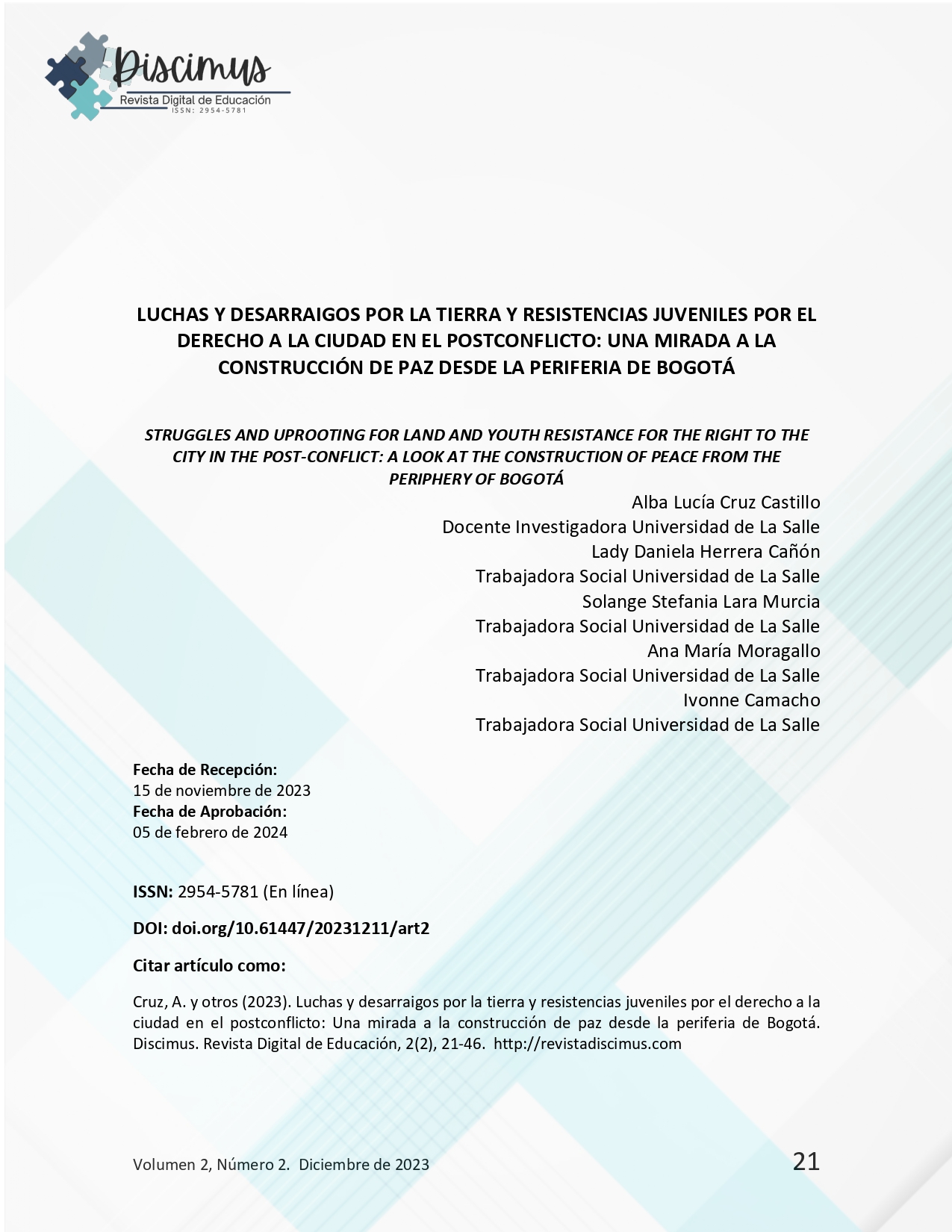Luchas y desarraigos por la tierra y resistencias juveniles por el derecho a la ciudad en el postconflicto: una mirada a la construcción de paz desde la periferia de Bogotá
Conteúdo do artigo principal
Resumo
El presente texto da cuenta de una investigación realizada a partir del año 2022, en el barrio El Recuerdo Sur de la Localidad de Ciudad Bolívar-Bogotá, cuyo propósito es contribuir a la generación espacio público y la reivindicación al derecho a la ciudad y que ha desplegado otras comprensiones sobre la necesidad de mirar la periferia, sus luchas sociales y resistencias colectivas en una perspectiva de postconflicto. El artículo da cuenta por lo tanto, del ejercicio metodológico en el acompañamiento y diálogo con esta comunidad que permitió visibilizar factores de marginalidad y exclusión social asociados a estas luchas y resistencia y el rol que los jóvenes cumplen en este proceso y que particularmente hacen del territorio un entramado de disputas que se encarnan en formas de reclamos sociales, que dan cuenta de una historicidad de colonizadores populares desplazados y desarraigados como efecto de la violencia social y política en Colombia.
##plugins.themes.bootstrap3.displayStats.downloads##
Detalhes do artigo
Seção

Este trabalho está licenciado sob uma licença Creative Commons Attribution-NonCommercial-ShareAlike 4.0 International License.
Política de Difusión Libre en la Revista Discimus
La revista Discimus tiene el compromiso de promover la libre circulación del conocimiento científico y académico, garantizando al mismo tiempo el reconocimiento adecuado a nuestros autores y respetando los principios éticos de la publicación científica. Con este objetivo, Discimus publica todos sus artículos bajo la licencia ATRIBUCIÓN-NOCOMERCIAL-COMPARTIRIGUAL 4.0 INTERNACIONAL CC BY-NC-SA 4.0
¿Qué significa esto para los autores, lectores y la comunidad científica?
CC (Creative Commons): Indica que la obra está bajo una licencia Creative Commons, lo que significa que se puede compartir y reutilizar bajo ciertas condiciones especificadas.
Como Citar
Referências
Alcaldía de Bogotá. (2020). Resumen de Informe de Rendición Pública de Cuentas de infancia, adolescencia y juventud de Bogotá. https://old.integracionsocial.gov.co/anexos/documentos/2019documentos/08072019_Informe%20ciudadano_Ciudad%20Bolivar.pdf
Bastidas, E. (Abril 23 de 2023). Entrevista personal para el trabajo de grado "Luchas y resistencias territoriales juveniles: una voz por la exigibilidad de derecho". (A. M. Mora Gallo, & I. N. Camacho Barbosa, Entrevistadores)
Berdegué, J.; Bebbington, A.; Escobal, J.; & otros. (2012). “Territorios en Movimiento. Dinámicas Territoriales Rurales en América Latina”. Documento de Trabajo Nº 110. Programa Dinámicas Territoriales Rurales. Rimisp, Santiago, Chile.
Blanco, O. E. M. (2006). Sur, periferias desplazadas en Bogotá. Cadernos Metrópole, (16), 13-33.
Caquimbo, S., Ceballos, O. y López, C. (2017). Espacio público, periferia urbana y derecho a la ciudad. Intervención Parque Caracolí, Ciudad Bolívar, Revista INVI, vol. 32, núm. 89, https://www.redalyc.org/journal/258/25850813004/html/
Carrillo, D. (21 de abril de 2023). Entrevista personal para el trabajo de grado "Luchas y resistencias terittoriales juveniles: una voz por la exigibilidad de derechos". (A. M. Mora Gallo, & I. N. Camacho Barbosa, Entrevistadores)
Cabrera, Magela. (2012) ESPACIO PÚBLICO Y DERECHO A LA CIUDAD, Centro de Estudios Latinoamericanos "Justo Arosemena", pp. 31-57, https://www.redalyc.org/pdf/5350/535055524003.pdf
Cáceres, T. (2012). Territorio y poder: el territorio de la carretera y el territorio de la Chimba*, Estudiante del Doctorado IDES/UNGS en Ciencias Sociales, Pp. 4-9. https://static.ides.org.ar/archivo/www/2012/04/02_DCSDossier.Palabras-Clave_Teresa.Caceres.pdf
Cruz Castillo, A.L; Rodíguez, E. y Vargas, M.F.(2023). Los Mapas Vivos Territoriales, premisas y usos para el fortalecimiento del ecoliderazgo en la educación rural. Documento innédito. Centro de Liderazgo y Excelencia Docente- Universidad de La Salle.
Escobar, A. (2017). Autonomía y diseño: la realización de lo comunal. Tinta Limón.
Herrera. M y Chaustre, A. (2012). Violencia urbana, memoria y derecho a la ciudad: experiencias juveniles en Ciudad Bolívar, Pro-Posições, Campinas, v. 23, n. 1 (67), p. 65-83. https://www.scielo.br/j/pp/a/8RBKMvN6C4wQN6DpLtwB8sQ/?lang=es&format=pdf
Fandiño, D. (2018, abril 27). ‘Survamos’: resistencia artística en Ciudad Bolívar contra la minería y la estigmatización. Cartel urbano. https://cartelurbano.com/arte-urbano-mincultura/survamos-resistencia-artistica-en-ciudad-bolivar-contra-la-mineria-y-la
Lopes de Souza, M. (1995) O territorio: sobre espaço e poder, autonomia e desenvolvimento, en De Castro, I.; P. Da Costa Gómez y Lobato Correa, R., Geografia: conceitos e temas, Ed. Bertrand, Río de Janeiro. pp. 77-116.
Mercedes, C. (2016), Determinantes del desplazamiento forzado en el Caquetá, Programa de las Naciones Unidas para el Desarrollo, pp. 1- 27. https://repositorio.uniandes.edu.co/bitstream/handle/1992/18154/u754118.pdf?sequence=1&isAllowed=y
Moreno, O. (2006). Sur, periferias desplazadas en Bogotá. Cadernos Metropole, (16), 13-33
Nates Cruz, B; Velásquez López, P.A & García Alon, M. (2016). La territorialización de la memoria en escenarios de posconflicto. Caldas 1990-2015. Centro Nacional de Memoria Histórica (CNMH).
Noticias RCN. (2022, marzo 30). Estas son las 5 estructuras criminales que delinquen en Ciudad Bolívar, según la Policía. Noticias RCN. https://www.noticiasrcn.com/bogota/cinco-estructuras-criminales-delinquen-en-ciudad-bolivar-414335
Rodríguez, J. (2016), Ciudades de la transición política hacia la paz Una propuesta de adaptación para la transición política hacia la paz, en el borde urbano rural de Ciudad Bolívar y Usme en la ciudad de Bogotá D.C, Universidad Piloto de Colombia, http://repository.unipiloto.edu.co/bitstream/handle/20.500.12277/8245/Ciudades_transici%C3%B3n%20pol%C3%ADtica%20hacia%20la%20paz-PapelesCoyuntura42.pdf?sequence=1&isAllowed=y
Observatorio Distrital de Víctimas del Conflicto Armado (2022). BOLETÍN TRIMESTRAL DE VÍCTIMAS DEL CONFLICTO ARMADO BOGOTA D.C. http://observatorio.victimasbogota.gov.co/sites/default/files/documentos/Bolet%C3%ADn%20V%C3%ADctimas%20Bogot%C3%A1%20-%20Febrero%202023.pdf
Ocampo et al, (2015), Del campo a la periferia de la ciudad, la omnipresente sombra de la violencia. Campesinos desplazados forzados en Colombia caminan de la mano del eterno retorno a la violencia: vulneración y potencia de vida, Universidad Externado de Colombia, https://www.redalyc.org/pdf/3051/305141020006.pdf
Prieto, J. C. (14 de Marzo de 2023). Entrevista personal para el trabajo de grado "Luchas y resistencias territoriales juveniles: una voz por la exigibilidad de derechos". (A. M. Mora Gallo, & I. N. Camacho Barbosa, Entrevistadores)
Ulibarri, P. y Fernández Droguett, P. (2018). La foto-etnografía como metodología de investigación para el estudio de manifestaciones conmemorativas contestatarias en el espacio público. Universitas humanística. 86, pp: 167-196. http://www.scielo.org.co/pdf/unih/n86/0120-4807-unih-86-167.pdf
Vega, A. (2011). Despojo de tierras campesinas y vulneración de los territorios ancestrales, Bogotá D.C., Colombia, https://www.corteidh.or.cr/tablas/r31910.pdf
Villarreal, Federico (2013). Complejidad y conflictividad territorial. Casos en el departamento de San Carlos, Salta. En Manzanal y Ponce (Org.) Controversias y disyuntivas del Desarrollo. Pp. 273-293

